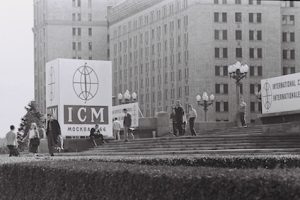It was August 1966 when Steven Smale reached Moscow to attend the International Congress of Mathematicians.
These congresses, veritable Olympiads of mathematics, had been held since 1897 at regular intervals of four years (except for the forced interruptions caused by the two world wars). The celebration of the fifteenth edition of the ICM in Moscow was an event of great significance as it involved the Soviet Union, with a mathematical community of enormous power, in the international cooperation associated with the congresses.
Smale had been awarded the Fields Medal, the most prestigious prize in mathematical research (why this is not the Nobel Prize in mathematics, which does not exist, is another story), which are always awarded at the beginning of the congresses. Three other mathematicians received the Fields Medal at that conference: Michael Atiyah from Oxford University, Paul Cohen from Stanford University and Alexander Grothendieck from the University of Paris.
Smale arrived with a double halo. On the one hand, he was a brilliant thirty-five-year-old mathematician who had been working on deep topological problems that had been unresolved for many years. In 1900 Henri Poincaré had asked whether the surfaces of “balls” in dimension 4 behaved as they did in dimension 3. This problem became known as Poincaré’s conjecture and, because of its difficulty, became the most famous of the open problems in topology. Smale tackled the problem boldly: instead of studying the problem in dimension 4, he went directly to higher dimensions, defying the established belief that “as the dimension increases, everything gets more complicated”. He was thus able to solve the problem for dimension 6 and higher. For this result he was awarded the Fields Medal (in 1986 Michael Freedman solved in the case of dimension 5; the outstanding case of dimension 4 – the one originally posed by Poincaré – was solved in 2002 by the Russian mathematician Grigori Perelman, for which he was awarded the Fields Medal at the International Congress of Mathematicians held in Madrid in 2006; Perelman declined the prize).
On the other hand, from his position at Berkeley University in California, Smale had been rather deeply involved in civil mobilisation against the Vietnam War, which included both university events and protests at the passing of trains carrying troops to Vietnam. These activities had consequences for Smale, including an official subpoena to testify before the Congressional Un-American Activities Committee.
Smale’s subpoena became known upon his arrival in Moscow, which led to the collection of signatures in Congress against the war in Vietnam and in support of American professors who opposed it. In this atmosphere, a North Vietnamese journalist asked Smale for an interview. Smale redirected the request to a press conference, so that the international press could attend and give an accurate account of his words. The press conference was held on Friday morning, 26 August, on the steps of Lomonosov Moscow State University, where Smale read out a statement:
I believe the American Military Intervention in Vietnam is horrible and becomes more horrible every day. I have great sympathy for the victims of this intervention, the Vietnamese people. However, in Moscow today, one cannot help but remember that it was only ten years ago that Russian troops were brutally intervening in Hungary and that many courageous Hungarians died fighting for their independence.
The following scene has all the ingredients of Cold War spy novels: as Smale finished his statement, and after talking to Soviet officials at the congress, he was escorted by two burly individuals to a car that speeded away. Hours later Smale returned to the congress, in time for the closing ceremony.
What had happened? Smale said he was taken on a tour of Moscow’s museums and later to the official Soviet press agency. “I was frightened, but I was treated not only politely, but as if I were a dignitary”. The incident was immediately reported in the international press. The New York Times ran a front-page photo of Smale “escorted” by the two individuals. The Soviet version highlighted Smale’s political activity and the FBI’s attempts to prevent his attendance at the Moscow congress, but did not mention his criticism at the press conference.
References
S. Batterson, Stephen Smale: the mathematician who broke the dimension barrier, American Mathematical Society, 2000, Providence, RI.
G. P. Curbera, Mathematicians of the world: Unite! The International Congress of Mathematicians: a human endeavor, A K Peters, 2009, Wellesley, MA.
(Imagen de S. V. Smirnov)


Leave a Reply